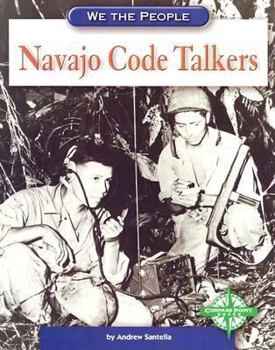Book Overview
Navajo Marines created a secret code using their Navajo language. Learn how this group of heroes helped the United States win World War II. This description may be from another edition of this product.
Format:Hardcover
Language:English
ISBN:0756506115
ISBN13:9780756506117
Release Date:January 2004
Publisher:Compass Point Books
Length:48 Pages
Weight:0.60 lbs.
Dimensions:0.3" x 7.5" x 9.0"
Age Range:9 to 11 years
Grade Range:Grades 4 to 6
Customer Reviews
1 rating
The fascinating story of the Navjao Code Talkers of World War II
Published by Thriftbooks.com User , 18 years ago
Code Breaking was an important part of World War II. The success of the Allies against the Axis powers was due in part to the ability to break Japanese and Nazi codes. Of course, enemy code breakers were trying to do the same thing with Allied codes. During the war, about 400 Navajos who served in the U.S. Marines Corps were employed as code talkers, sending and receiving codes messages. The code they invented was never broken by the enemy and was based on the Navajo language. In a war that would be ended by the advanced technology of atomic bombs, the simple elegance of using a Native American language to befuddle Japanese code breakers is one of the most interesting footnotes of World War II. In "Navajo Code Talkers," Andrew Santella begins with how Pearl Harbor got the United States into the war and how being able to communicate battle plans and information over long distances was crucial to military success. The Japanese listened in to American military radio messages (there is even a photograph of them doing this) and the American military had developed codes that were so complex they took hours to translate messages. Then Philip Johnson, a Los Angeles engineer who was the son of missionaries who had worked the Navajos, came up with the idea of using the Navajo language to make a simple code that would be almost impossible to break. Santella explains how the pronunciation and tone of each syllable is crucial in Navajo, and how the Army had used Native American languages in both World War I and World War II (File this under the "I did not know that" category). I always thought the Navajo simply spoke in their own language, but indeed a code was developed based on the language. After providing a section on the history of the Navajo, Santella looks at the training of the original 29 Navajos as code breakers, emphasizing the clash with Navajo traditions. Then we get to the interesting section, which explains how the code was created. Basically, they used Navajo words to represent each English letter, from Wol-la-chee (ant) for "A" to Besh-do-tilz (zinc) for "Z." Because some English letters could be represented by as many as three different Navajo words (e.g., be-la-sana for apple and tse-nill for axe), the code could be complicated by simple means. They also used Navajo words for English words, such as Gini (chicken hawk) for dive-bomber and Ne-hem-ah (Our mother) for America. I can see a bunch of school children across the country are going to use the material in this book for a poster presentation (those are getting a lot more complicated than they were in my day, that is for sure). The rest of the book look at how this worked on the battlefields of most of the major battles fought in the Pacific theater, what happened when the Navajos returned home after the war. It was not until 2001 that Congressional gold medals were presented to each of the 29 original code talkers, only five of who were still alive. Silver medals wer




